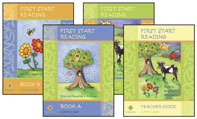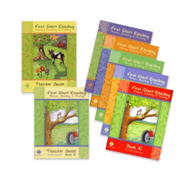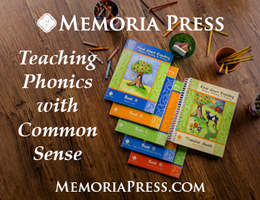First Start Reading (FSR) is an intensive phonics, introductory course that begins with letters and sounds and continues through long-vowel words in kindergarten. In first grade, it completes the phonics foundation by teaching long-vowel digraphs, soft c and g, and the three sounds of y. It also teaches manuscript printing in kindergarten, but you can delay that instruction if a child does not yet have the small motor coordination required.
The kindergarten course consists of a teacher guide and four student workbooks—First Start Reading Book A, FSR Book B, FSR Book C, and FSR Book D. You can also use Memoria Press’ Classical Phonics for additional phonics/reading practice although it’s not essential. There is a surprisingly large amount of reading practice in FSR itself.
Instructions to the teacher are refreshingly brief compared to some other phonics programs. Lessons are presented by the parent or teacher using the teacher guides, student workbook, and a whiteboard.
FSR teaches just a few letters, then immediately teaches blending, first using vowel-consonant combinations such as “am” and “an,” then word families such as “it, fit, pit, hit,” and “sit.” FSR also begins with the “liquid” consonants that are easily voiced by themselves which makes it easier for children to learn to blend the phonograms. For instance, it is easier to blend “m” and “a” than “b” and “a” since the temptation is to add an “uh” sound after the “b.”
Essential sight words are taught as needed so that students are able to read the sentence, “I am Sam” during the fifth lesson. They are reading short stories later on in the first workbook, albeit with limited vocabulary. In keeping with author Cheryl Lowe’s classical approach to education, she includes a daily recitation that you might want to use. During the recitation, children review the basic sounds of the letters along with the concepts of upper and lower case, and vowels and consonants.
One feature that sets FSR apart is the emphasis on proper instruction in printing, especially on pencil grip. This is one of the issues often overlooked until too late when children have already formed habits of holding their pencils with an awkward death grip that makes writing a difficult chore. Lowe describes an excellent way to teach children how to pick up and hold their pencils so that they get it correct from the beginning. She also emphasizes the importance of monitoring pencil grip. Printing instruction is taught as children learn the phonograms, but again, you can separate the printing instruction and save it for later if need be. Those learning printing also learn to take words by dictation.
You will need to teach from the teacher guide as you start but will frequently be able to work with students just from their workbooks. Simple assessments are included but if you are working with only one child you might not need to use these since you will already know what a child is able to read, print, and take by dictation.
Student books have lines for printing letters and words, models of the letters and words, dotted line models that students trace, a coloring page and drawing space for every letter, and occasional boxes for drawing a picture that relates to a story in the lesson. Student books have some simple black-and-white illustrations but are not heavily illustrated.
For first grade, students continue with FSR E, a course that consists of a teacher guide and a student book.
The EPS Primary Phonics Readers are recommended as supplements for both kindergarten and first-grade level, but they are not required.
FSR is used within Memoria Press’Classical Curriculum complete programs or may be purchased separately. FSR is one of the most affordable options for teaching reading that does not require that you purchase other readers.
First Start Reading (FSR) is an intensive-phonics, introductory course that begins with letters and sounds and continues through long-vowel words in kindergarten. In first grade, it completes the phonics foundation by teaching long-vowel digraphs, soft c and g, and the three sounds of y. It also teaches printing in kindergarten, but you can delay that instruction if a child does not yet have the small-motor coordination required.
The kindergarten course consists of a teacher guide and four student workbooks—First Start Reading: Book A, FSR: Book B, FSR: Book C, and FSR: Book D. You can also use Memoria Press’s Classical Phonics for additional phonics instruction and reading practice, although it’s not essential. In addition, Memoria Press's First Start Reading Storybook series, with five books labeled A through E, can be used alongside each First Start Reading book, but they too are not required. There is a surprisingly large amount of reading practice in FSR itself.
Instructions to the teacher are refreshingly brief compared to some other phonics programs. Lessons are presented by the parent or teacher using the teacher guides, student workbook, and a whiteboard.
FSR teaches just a few letters and then immediately teaches blending, first using vowel-consonant combinations, such as am and an, and word families such as it, fit, pit, hit, and sit. FSR also begins with the “liquid” consonants that are easily voiced by themselves which makes it easier for children to learn to blend the phonograms. For instance, it is easier to blend m and a than b and a since the natural thing is to add an uh sound after the b.
Essential sight words are taught as needed so that students are able to read the sentence, “I am Sam” during the fifth lesson. They will read short stories later on in the first workbook, albeit with limited vocabulary.
In keeping with author Cheryl Lowe’s classical approach to education, she includes a daily recitation that you might want to use. During the recitation, children review the basic sounds of the letters along with the concepts of uppercase and lowercase and vowels and consonants.
One feature that sets FSR apart is the emphasis on proper instruction in printing, especially on pencil grip. This is one of the issues often overlooked until too late when children have already formed habits of holding their pencils with an awkward death grip that makes writing a difficult chore. Lowe describes an excellent way to teach children how to pick up and hold their pencils so that they get it correct from the beginning. She also emphasizes the importance of monitoring pencil grip. Printing instruction is taught as children learn the phonograms, but again, you can separate the printing instruction and save it for later if need be. Those learning printing also learn to write out words presented by dictation.
You will need to teach from the teacher guide as you start but will frequently be able to work with students just from their workbooks. Simple assessments are included but if you are working with only one child you might not need to use these since you will already know what a child is able to read, print, and take by dictation.
Student books have lines for printing letters and words, models of the letters and words, dotted-line models that students trace, a coloring page, drawing space for children to draw something beginning with the letter, and occasional boxes for drawing a picture that relates to a story in the lesson. Student books have some simple black-and-white illustrations but are not heavily illustrated.
For first grade, students continue with FSR: Book E, a course that consists of a teacher guide and a student book.
First Start Reading is used within Memoria Press’s Classical Curriculum complete programs or may be purchased separately. FSR is one of the most affordable options for teaching reading that does not require that you purchase other readers.












